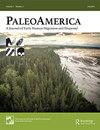另一个“批评”,同样的老歌:对Gómez的简短反驳
IF 1.7
Q1 ANTHROPOLOGY
引用次数: 5
摘要
本文是对Gómez Coutouly在本期《古美洲》杂志上发表的文献综述的简短回应。我们重申,Piauí东南部更新世遗址的人类活动性质已经得到证实。在此基础上,我们展示了多少持主流思维的怀疑论者复制了一种关于美洲人类的科学意识形态。本文章由计算机程序翻译,如有差异,请以英文原文为准。
Another “Critique,” Same Old Song: A Brief Rebuttal to Gómez Coutouly
ABSTRACT This comment is a brief response to the bibliographic review made by Gómez Coutouly in this issue of PaleoAmerica. We reaffirm that the anthropic nature of the Pleistocene sites in the southeast of Piauí has already been demonstrated. Based on this, we show how many skeptics with mainstream thinking reproduce a scientific ideology regarding the peopling of the Americas.
求助全文
通过发布文献求助,成功后即可免费获取论文全文。
去求助
来源期刊

PaleoAmerica
Earth and Planetary Sciences-Paleontology
CiteScore
3.70
自引率
0.00%
发文量
15
期刊介绍:
PaleoAmerica disseminates new research results and ideas about early human dispersal and migrations, with a particular focus on the Americas. It fosters an interdisciplinary dialog between archaeologists, geneticists and other scientists investigating the dispersal of modern humans during the late Pleistocene. The journal has three goals: First and foremost, the journal is a vehicle for the presentation of new research results. Second, it includes editorials on special topics written by leaders in the field. Third, the journal solicits essays covering current debates in the field, the state of research in relevant disciplines, and summaries of new research findings in a particular region, for example Beringia, the Eastern Seaboard or the Southern Cone of South America. Although the journal’s focus is the peopling of the Americas, editorials and research essays also highlight the investigation of early human colonization of empty lands in other areas of the world. As techniques are developing so rapidly, work in other regions can be very relevant to the Americas, so the journal will publish research relating to other regions which has relevance to research on the Americas.
 求助内容:
求助内容: 应助结果提醒方式:
应助结果提醒方式:


